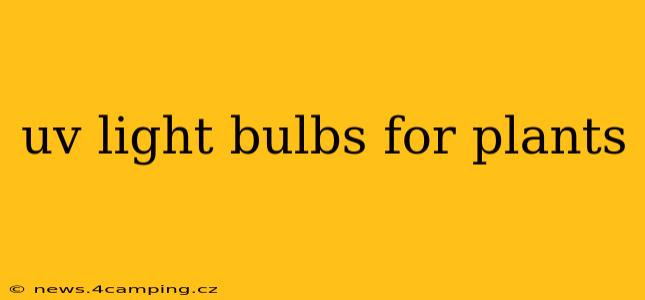Ultraviolet (UV) light plays a crucial role in plant health, though not in the way visible light does. While plants primarily use visible light for photosynthesis, UV light, specifically UVB, triggers various physiological responses that influence growth, defense mechanisms, and overall plant resilience. This article delves into the use of UV light bulbs for plants, exploring their benefits, drawbacks, and best practices for implementation.
What are the benefits of using UV light bulbs for plants?
UV light exposure, in controlled amounts, offers several advantages for plant growth and development. It stimulates the production of secondary metabolites, acting as a natural defense mechanism against pests and diseases. These metabolites often contribute to the plant's overall robustness and stress tolerance. Moreover, UV-B light can enhance the production of certain beneficial compounds, potentially impacting the nutritional value or flavor profile of fruits and vegetables. Finally, some studies suggest that controlled UV-B exposure might improve the compactness and structural integrity of plants.
What are the different types of UV light bulbs for plants?
Several types of UV light bulbs cater to plant cultivation. The key distinction lies in the wavelength emitted. UV-A bulbs, while less potent in influencing plant physiology, offer supplemental lighting alongside other light sources. UV-B bulbs are more specialized, offering the crucial wavelengths that trigger the protective responses in plants. It's vital to choose bulbs with a specific output in nanometers (nm) tailored to the plant species. Consult research specific to your plants to find the ideal spectrum and intensity.
How much UV light do plants need?
The optimal amount of UV light for plants varies considerably depending on the species, growth stage, and overall environmental conditions. Overexposure to UV radiation can be detrimental, causing damage to plant tissues and hindering growth. Therefore, it's crucial to introduce UV light gradually and monitor the plants closely for any signs of stress, such as leaf discoloration or stunted growth. Starting with low intensity and gradually increasing exposure is recommended.
Are UV light bulbs safe for humans and pets?
UV-B light, while beneficial for plants in controlled environments, can be harmful to human skin and eyes. Prolonged exposure can lead to sunburn and eye damage. Similarly, some pets can be sensitive to UV radiation. Therefore, it's essential to take precautions when using UV light bulbs for plants. Wear protective eyewear and clothing when handling UV bulbs, and ensure the bulbs are safely enclosed to prevent direct exposure to humans and pets.
Do all plants benefit from UV light?
No, not all plants benefit equally from supplemental UV light. While many species exhibit positive responses, some may be less sensitive or even negatively affected. The response varies across different plant families and even cultivars within a species. Research on the specific light requirements of your plant species is crucial before introducing UV light.
How do I use UV light bulbs for plants effectively?
Effective implementation of UV light bulbs involves careful consideration of several factors. The distance between the light source and the plants is critical. Too close and you risk burning the foliage; too far and the effects will be minimal. The duration of UV exposure is equally important, starting with short periods and gradually increasing them while carefully observing the plants' response. The overall light spectrum, including visible light, must also be considered. UV light should supplement, not replace, other light sources.
What are the potential drawbacks of using UV light for plants?
While beneficial in controlled amounts, excessive UV light can severely damage plants. This can manifest as leaf burn, stunted growth, and reduced overall plant health. Furthermore, improper installation or handling of UV light bulbs poses risks to humans and pets. It's vital to follow safety guidelines and monitor plants closely for signs of UV-induced damage.
Conclusion:
UV light bulbs can be a valuable tool for enhancing plant growth and health when used correctly. Understanding the specific needs of your plant species, implementing gradual exposure, and employing appropriate safety measures are crucial for achieving positive results. Always prioritize research and careful monitoring to avoid the negative consequences of excessive UV radiation. By carefully considering the factors outlined above, growers can successfully harness the benefits of UV light to cultivate healthier, more resilient plants.
